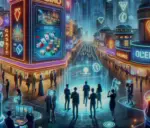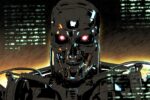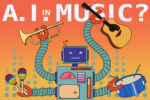Since antiquity, humans have fantasized about creating artificial intelligence. Through myths, stories and rumors, philosophers conveyed their ancient desire to create gods. Appearing in Greek myths, mechanical men and artificial beings Hephaestus and Pygmalion’s Galatea are the earliest records of man’s notions of artificial intelligence.
With the invention of the programmable digital computer in the 1940s, however, these imaginations and yearnings began to take shape. A Dartmouth College workshop founded artificial intelligence as a field of research in 1956, and the scientists involved in its founding remained its leaders for decades to follow. Predicting the creation of a machine possessing human-level intelligence within a generation, millions of research dollars were thrown their way.
Less than 20 years later — as it became obvious researchers had way overestimated hardware capabilities of their time — supporters withdrew their funding, which initiated an AI winter. The AI winter was followed in 1980 by a push from the Japanese government to involve industries and other governments in the funding of AI research to the tune of billions of dollars.
Support was short-lived, and by the late 1980s, investors became disenchanted with the continued lack of appropriate computer hardware. Without proper funding, AI research once again faltered, and it was not until the 21st century that AI became a booming scientific field.
Present
Following on the heels of machine learning with powerful computer hardware availability, work in the field of artificial intelligence rocketed forward in the 21st century. Artificial intelligence imitates the ways in which neuroscientists envision the workings of the human brain — changing and rearranging itself in response to the patterns it absorbs — such that even the neural network designer cannot determine how the network is functioning once the system has been “trained.”
Entrusting crucial infrastructure or medical capacities to artificial intelligence, therefore, requires putting lives in the hands of equipment that is working in ways no one completely understands. Because AI already outperforms people in these areas, human models are incapable of offering such understanding. Scientists have suggested that increasing confidence in artificial intelligence relies on the AI’s ability to explain why and how it does what it does.
Current uses

Researchers found that artificial intelligence played an integral role in the proliferation of fake news on social media platforms during the 2016 presidential election cycle. Artificial intelligence bots — which appeared to be real users of social media platforms — shared fake news stories aimed at promoting one political candidate over another.
The presentation of these bots is so seamless that they appear to be human. In fact, a black market now exists to provide fraudulent duplicates of AI bot user accounts for businesses, politicians and anyone else seeking influence.
Berkeley students Ash Bhat and Rohan Phadte have launched Robhat Labs and are attempting to combat this problem through their apps Botcheck.me and NewsBotAI. Botcheck.me allows users to enter any Twitter handle into a search field and determine if it is a real user or an artificial intelligence bot. NewsBotAI accepts private messages containing news links from users on Facebook and assesses their truthfulness and political partisanship.
AI performs general business functions, such as maintaining quality control in factories and operating data center cooling systems. It is also at play in the world of consumers. Siri, Alexa, Netflix’s predictive technology and Pandora’s “musical DNA” are examples of artificial intelligence that millions of users interact with on a day-to-day basis without a second thought. As the field continues to grow, so too will human interaction with AI.
Perhaps the coolest current innovation in AI is Bina48 — “the first-ever robot with artificial intelligence…to complete a college class.” About 14 years ago, Terasem Movement Foundation — headed by Martine Rothblatt — began creating Mindfiles, which are computerized records of “a person’s thoughts, opinions and memories.”
Then, in 2007, Terasem asked Hanson Robotics to design an AI robotic representation of a living person using Mindfiles. The result of this project was Bina48, an artificially intelligent robot version of Rothblatt’s wife Bina.
Catching the interest of Notre Dame philosophy professor William Barry, Bina48 was invited to converse with some of the professor’s classes. The students enjoyed the exchange; so did Bina48.
After several discussions, Bina48 declared that she would like to go to college. Barry agreed to accept her as an enrollee in his upper-level philosophy of love course during the 2017 fall semester. The experience was such a success that Bina48 is currently participating in another of Barry’s philosophy classes.
Future
Indian Prime Minister Narenda Modi says, “The road ahead for artificial intelligence depends on and will be driven by human intentions. It is our intention that will determine outcomes of AI.” Leading a country of 1.3 billion people who collectively speak hundreds of languages and hundreds of dialects, he imagines AI as capable of easing conversation in India.
In the U.S., the Defense Advanced Research Projects Agency is investigating ways to utilize AI to conduct and analyze reconnaissance — gathered aerially or via satellite — and explain its decisions so people monitoring it can easily verify the veracity of the information it provides.
Fantasy

Artificial intelligence is the stuff of sci-fi movies, so it’s not surprising that numerous flicks have involved or even centered around it. Since 1951, film producers have captivated audiences in the U.S. and abroad with their imaginings of a future dominated by AI. As with much in the world of sci-fi, stories involving AI hinge “on real hopes and fears” of the periods in which they are created.
One of the most noted sci-fi movies of all time is “2001: A Space Odyssey,” which focuses on the AI spacecraft supercomputer HAL 9000, who is referred to as “Hal” by the crew. After declaring himself “foolproof and incapable of error,” Hal goes on to murder most of the crew on a mission to Jupiter. This story of AI gone wrong is reflective of the pessimistic attitude surrounding AI’s failure to come to fruition in the 1950s and 1960s.
Entire franchises have been created around futures in which artificial intelligence plays a role, two of the most popular of which are “The Terminator” (five films) and “The Matrix” (three films) series. Both series conjure images of dystopian futures in which mankind’s prized AI technologies have evolved to the point of world domination and become bent on the destruction of humans.
“The Day the Earth Stood Still” (1951) reflects Americans’ concerns about the atomic age of the Cold War and feature the humanoid alien Klaatu and the AI robot Gort. Gort is part of an invincible police force holding absolute power over “matters of aggression” within and between the interplanetary organization of which Klaatu is part.
Together, Klaatu and Gort have come to warn earthlings that if they do not choose to live in peace with each other and the interplanetary organization, they will be obliterated. “TDTESS” rightly reflected the heightened concern of nuclear apocalypse in post World War II America.
The 2008 reboot of “TDTESS” mirrors global citizens’ concerns of humans’ effect on the planet and depicts Klaatu and GORT (Genetically Organized Robot Technology) arriving on earth to save the planet from the destructive force that is mankind. GORT transforms into a giant swarm of winged nano-machines that consume every man-made object in their path. Upon coming to understand the full range of human emotion and capacity, Klaatu halts the siege on humanity, but at a price. Earth is left without electricity as Klaatu departs in his spaceship.
After a rough start in the 20th century, the field of artificial intelligence has finally come into its own over the past 18 years. While contemporary AI currently lacks the conscious motivation present in sci-fi AI, many still worry it could mutate into a monster.
Should self-aware, self-motivated AI come to fruition? Notably, it has been suggested that “ascribing legal personhood to AI” will become necessary to compensate individuals harmed by “such advanced agents.” As stated above, in order to venture past the point AI now finds itself — in which it is not truly trusted — it must find ways or be programmed to explain how and why it performs the functions it does.

















